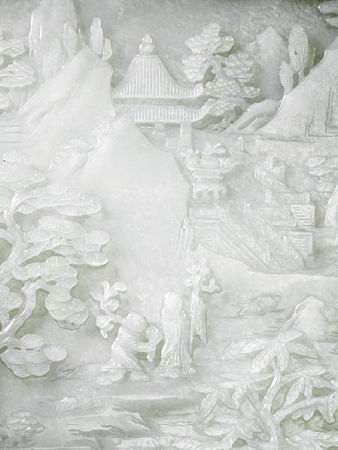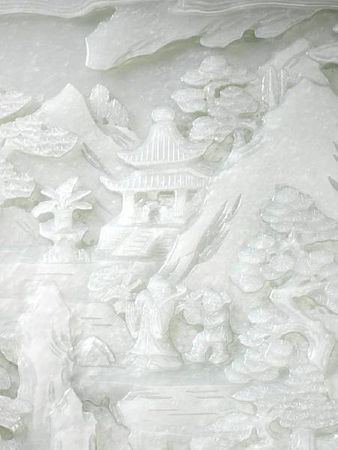An important pair of white jade 'landscape' screens. Qianlong.
An important pair of white jade 'landscape' screens. Qianlong. Photo Bonhams
Each carved on both sides from a very fine rectangular translucent plaque of even very pale tone, one panel with an elderly Immortal carrying a staff and attendant carrying a branch of fruiting peach, on a terrace between a large leafy pine and sterculia, the right background with a multi-roofed pagoda in an enclosure, the reverse with a stag and a doe at the bank of a river and leafy branches issuing from overlapping mountain ridges; the other panel with a similar elderly Immortal and attendant in a somewhat similar mirror image, the details all very crisply incised, the reverse with a crane standing beneath pine beside a waterfall and another in flight above, fitted box, wood stands. 23cm x 18cm (9 1/8in x 7 1/8in) (5). Sold for £356,000
Provenance: Sotheby's London, 16 June 1999, lot 760
Roger Keverne Ltd., London, 1999
An English private collection
The quality of workmanship on this magnificent pair of screens compares favourably with the most outstanding examples from the Qianlong period, and they would surely have adorned the desk of a high-ranking official or a member of the Imperial family.
Jade table screens were one of the most popular forms of jade lapidary work during the Qing Dynasty. Either rectangular or circular in form, they were supported on elaborate wood stands and were produced in pairs to adorn palaces and the scholar's studio.
It was the Qianlong Emperor who set the trend for 'huayi' jade, meaning 'jade like a picture', where the objective was to render in jade what a painter could do on paper. Examples of Qianlong period 'huayi' jades include large jade mountains, brush pots carved with continuous landscapes, and jade screens, such as the present lot. The Qianlong Emperor rated such 'huayi' jades highly, considering them comparable in excellence to the 'fanggu' jades (jades made in imitation of antiques) and wrote many poems in praise of both types. In one of his poems he describes a carved jade screen:
This piece of precious jade slab is from Khotan. It is unsuitable for making vessels such as the dragon 'hu' and animal 'lei'. In order to fully utilise it, it is carved into a panel with the scene of 'A Riverside City on a Spring Morning....It takes ten days to carve a tiny bit of water and five days to shape a piece of rock. The crafting is indeed very time-consuming. See Yang Boda, 'Jade: Emperor Ch'ien Lung's collection in the Palace Museum, Peking', Arts of Asia, March-April 1992.
It is incredibly rare to find a pair of such screens. For other Qianlong-period pairs of white jade 'huayi' screens, see a pair in the Art Museum of the Chinese University of Hong Kong, illustrated in Virtuous Treasures. Chinese Jades from the Scholar's Table, Hong Kong, 2007, Catalogue no.43; and a circular white jade pair from the collection of Alan and Simone Hartman, sold at Christie's Hong Kong, 27 November 2007, lot 1511.
The theme of Shoulao and his attendant frequently appeared on white and spinach-green jade table screens during the Qianlong period. See another example from the Michael S. L. Liu Collection, illustrated in Virtuous Treasures. Chinese Jades from the Scholar's Table, Hong Kong, 2007, Catalogue no.45. See also a single circular pale green jade table screen depicting Shoulao and attendants on one side, and cranes in flight on the reverse, sold in our Hong Kong rooms, 24 November 2010, lot 251; and a spinach-green jade example, from the Buchanan-Jardine Collection, sold in the same rooms, 4 December 2008, lot 204.
Bonhams. Fine Chinese Art, 12 May 2011, New Bond Street www.bonhams.com

/https%3A%2F%2Fprofilepics.canalblog.com%2Fprofilepics%2F1%2F0%2F100183.jpg)
/https%3A%2F%2Fstorage.canalblog.com%2F03%2F02%2F119589%2F96711876_o.jpg)
/https%3A%2F%2Fstorage.canalblog.com%2F11%2F31%2F119589%2F94773502_o.jpg)
/https%3A%2F%2Fstorage.canalblog.com%2F20%2F83%2F119589%2F94772815_o.jpg)
/https%3A%2F%2Fstorage.canalblog.com%2F26%2F72%2F119589%2F75604929_o.jpg)
/https%3A%2F%2Fstorage.canalblog.com%2F59%2F60%2F119589%2F26458628_o.jpg)







/http%3A%2F%2Fstorage.canalblog.com%2F51%2F84%2F119589%2F122518624_o.jpg)
/http%3A%2F%2Fstorage.canalblog.com%2F42%2F87%2F119589%2F112989160_o.jpg)
/http%3A%2F%2Fstorage.canalblog.com%2F28%2F52%2F119589%2F112495720_o.jpg)
/http%3A%2F%2Fstorage.canalblog.com%2F12%2F27%2F119589%2F96148405_o.jpg)